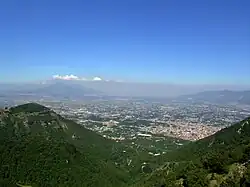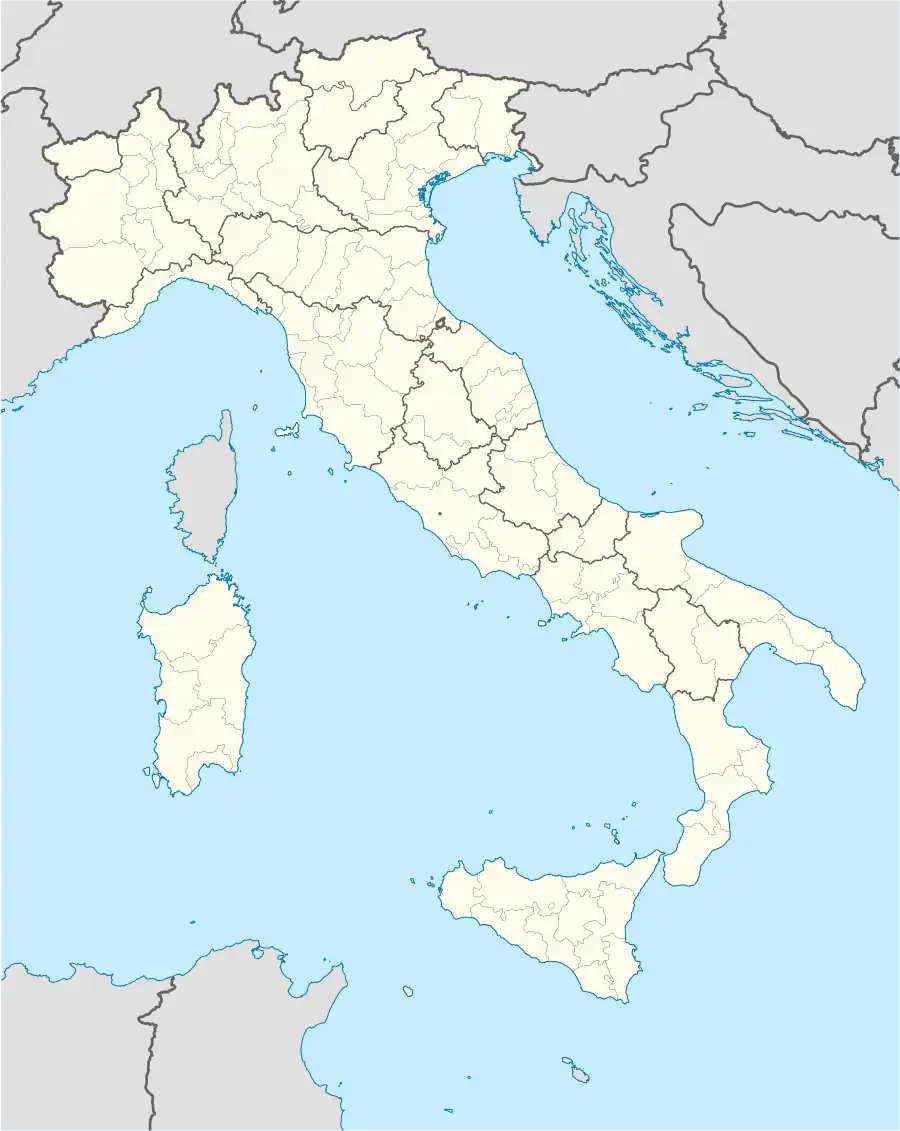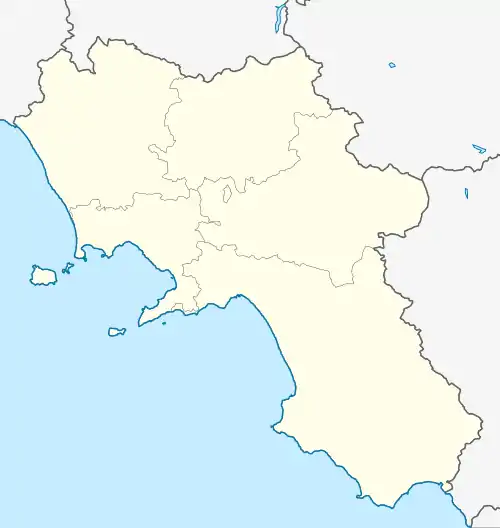Nocera dei Pagani
Nocera dei Pagani[lower-alpha 1] (Latin: Nuceria Paganorum) is the name under which was known in the past, between the 16th century and 1806, a civitas that included a large portion of the Agro nocerino-sarnese, composed of 5 existing municipalities: Nocera Inferiore, Nocera Superiore, Pagani, Sant'Egidio del Monte Albino and Corbara.
Nocera dei Pagani | |
|---|---|
| Nuceria Paganorum | |
 Views of Nocera dei Pagani. | |
Location of Nocera dei Pagani | |
 Nocera dei Pagani Location of Nocera dei Pagani in Italy  Nocera dei Pagani Nocera dei Pagani (Campania) | |
| Coordinates: 40°44′N 14°37′E | |
| Country | Italy |
| Region | Campania |
| Province | Province of Salerno |
| Area | |
| • Total | 62 km2 (24 sq mi) |
| Demonym | Nucerin |
| Time zone | UTC+1 (CET) |
| • Summer (DST) | UTC+2 (CEST) |
| Postal code | 84010; 84014 to 84016 |
| Patron saint | St. Alphonse |
| Saint day | August 1 |
History
In the period before the Roman supremacy in southern Italy, it was included into the territory of Nuceria, the chief town in the valley of the Sarnus, Herculaneum, Pompeii, Stabiae and Surrentum all being dependent upon it, according to many archaeologists. It maintained its allegiance to Rome till 309 BC when it joined the revolted Samnites.[1] In 308 BC it repulsed a Roman attempt to land at the mouth of the Sarnus, but in 307 BC it was besieged and surrendered. It obtained favourable terms, and remained faithful to Rome even after Cannae.[1]
Hannibal reduced it in 216 BC by starvation, and destroyed the town of Nuceria. The inhabitants returned when peace was restored. Even during the Social War it remained true to Rome. In 73 BC it was plundered by Spartacus.[1]
Saracen colony
In the Middle Ages (around the 9th century) a small colony of Saracens was actually introduced in the annexed territory of nowadays Pagani by permission of the Dukes of Naples; according to most sources, it lasted only a few decades, but other sources state that a second colony of Muslim Saracens was later introduced by Frederick II.[2] The town was described as "a genuine Muhammadan town with all its characteristic mosques and minarets."[3] It is said that, through their darker complexion and features, the townsfolk maintain the heritage of these Muslim settlers.[4]
After the mid-9th century the town was part of the principality of Salerno first, and then of the principality of Capua.
Pagano family
The House of Pagano, an ancient noble family of local lords living in the castle of Cortimpiano (Latin: Curtis in Plano), in the territory of Pagani, apparently took this surname from the Saracen pagans who previously inhabited the area. A family member named Ugo dei Pagani is credited as crusader knight and founder of the Knights Templar. Reference to Nocera as his birthplace is found at least as early as Baedeker's Southern Italy (1869)[5] and is also found in the Old Catholic Encyclopedia.[6] Two more recent writers say that the theory is supported by a letter that Hugues wrote from Palestine in 1103, in which he talked of writing to "my father in Nocera" to tell him of the death of his cousin Alessandro.[7][8]
Second millennium
The citadel of Nuceria, located where the future Nocera Inferiore would rise, was besieged by Roger II of Sicily in the battle in 1132, after four months he razed the town to the ground. After its reconstruction, the birth of the modern Nocera began with many hamlets and villages which gradually expanded and became small towns.
During the Angevin dominion (1266–1435) Nocera was rebuilt and took the name of Nuceria Christianorum. In 1385 Pope Urban VI was besieged in the city castle by Charles III of Naples.
In the XV century the town name was changed to Nuceria Paganorum (Italian: Nocera dei Pagani) in honor to the Pagano family, itself named after the Saracen pagans who previously inhabited the area.
Throughout the Spanish domination Nocera was divided into five municipalities: Nocera Soprana, Nocera Sottana, Barbazzano, Pagani and Sant'Egidio, each one with its own mayor. Toward the end of the 16th century the town was then divided into seven municipalities:
- Nocera Corpo, including the current Nocera Superiore and Nocera Inferiore districts of Piedimonte, Pietraccetta and Borgo;
- Nocera San Matteo, including the current Nocera Inferiore districts of Merichi and Liporto;
- Nocera Tre Casali, including the current Nocera Inferiore districts of Capo Casale, Casale Nuovo and Casale del Pozzo;
- Barbazzano;
- Pagani;
- Sant'Egidio;
- Corbara.
The town survived until 1806. In 1807 comuni were established: Sant'Egidio and Corbara stayed autonomous, and Barbazzano was merged into Pagani, while Nocera San Matteo and Nocera Tre Casali merged to form the current Nocera Inferiore, initially joined by Nocera Corpo, but in 1828 the fourteen districts of Nocera Corpo asked for self-administration which was granted by decree № 1960 on 11 November 1850, with effect from 1 January 1851; thus was born the current Nocera Superiore.
See also
Notes and references
Notes
- Often shortened as Nocera de' Pagani.
References
- Belsito, Francesco; De Pascale, Carmine (2013). Storia di Pagani. Monumenti, personaggi, tradizioni. Angri: Gaia.
- Chisholm, Hugh, ed. (1911). . Encyclopædia Britannica. Vol. 19 (11th ed.). Cambridge University Press. p. 730.
- Robert Browning (1984). The Poetical Works of Robert Browning: Volume II. Strafford, Sordello (reprint, annotated ed.). Clarendon Press. p. 300. ISBN 9780198123170.
- Walter Scott (31 Aug 2013). Douglas, David (ed.). The Journal of Sir Walter Scott: Volume 2: From the Original Manuscript at Abbotsford (illustrated ed.). Cambridge University Press. pp. 470–1. ISBN 9781108064309.
In the latter village [Nocera Inferiore] the Saracens obtained a place of refuge, from which it takes the name. It is also said that the circumstance is kept in memory by the complexion and features of this second Nocera, which are peculiarly of the African caste and tincture.
- Karl Baedeker, Italy: handbook for travellers. Part 3 (Coblenz, 1869) p. 145
- Nocera dei Pagani in Catholic Encyclopedia vol. 11 (1911)
- Rotundo, Domenico (1983). Templari, misteri e cattedrali. Rome. p. 38. ISBN 9788865010006. Retrieved 25 May 2012.
Ho scritto a mio padre in Nocera che mi faccia gratia venire a Rossano per consolare V.S. et a Madama Zia Hippolita
{{cite book}}: CS1 maint: location missing publisher (link) - Mario Moiraghi, L'Italiano che fondò i Templari. Hugo de Paganis cavaliere di Campania (Edizioni Ancora, 2005. ISBN 978-8851402792) See interview with Moiraghi